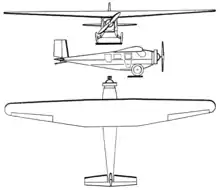Messerschmitt M 18
The Bayerische Flugzeugwerke M 18 (BFW M 18), (later known as Messerschmitt M 18) was an airliner, produced in Germany in the late 1920s.
| M 18 | |
|---|---|
.jpg.webp) | |
| An Armstrong-Siddeley Lynx-powered M-18d of Ad Astra Aero in Switzerland | |
| Role | Airliner |
| National origin | Germany |
| Manufacturer | Messerschmitt / Bayerische Flugzeugwerke (BFW) |
| Designer | Willy Messerschmitt |
| First flight | 1926 |
| Primary user | Nordbayerische Verkehrsflug |
| Number built | ca 24 |
Design and development
Designed at the request of Theodor Croneiss to supply his new airline venture which was to become Nordbayerische Verkehrsflug (NOBA),[1] it was a conventional high-wing cantilever monoplane with fixed tailskid undercarriage. The prototype was built of wood, although production examples would have a metal structure.[2] The design was praised in its day for the cleanness of its aerodynamics, lightness of construction, and economy of operation[3][4]
Operational history
.jpg.webp)
The first M 18 to enter service with NOBA was provided by Messerschmitt in exchange for a 49% share of the new company, and on 26 July it began commercial flights.[5] NOBA's early successes enabled the company to place orders for additional examples of an improved model, the M 18b. It would eventually purchase twelve of these,[1] but manufacturing them would exceed the capacity of Messerschmitt's own small firm, leading to a merger with Bayerische Flugzeugwerke (BFW) in 1927. Following NOBA's reorganisation into DEVAG in 1931, a small number of a further-improved version, designated M 18d, were ordered, but the type was soon superseded by the similar but larger Messerschmitt M 20.[2]
Variants
- M 18a
- three-seat production version with 60 kW (80 hp) Siemens-Halske Sh 11 engine (two built)
- M 18b
- three/four-seat production version with 82 kW (110 hp) Siemens-Halske Sh 12 engine (12 built)
 Messerschmitt M.18b photo from Les Ailes December 15,1927
Messerschmitt M.18b photo from Les Ailes December 15,1927 - M 18c
- photographic survey version with 164 kW (220 hp) Armstrong Siddeley Lynx engine (two or three built)
- M 18d
- enlarged six/seven/eight-passenger version, produced with a variety of engines, including the 164 kW (220 hp) Armstrong Siddely Lynx, 112 kW (150 hp) Walter Mars and 240 kW (320 hp) Wright Whirlwind. (eight built)
Specifications (M 18d)

Data from Messerschmitt: an aircraft album,[6] Flugzeug-Typenbuch 1936[7]
General characteristics
- Crew: 1
- Capacity: 7 passengers
- Length: 9.4 m (30 ft 10 in)
- Wingspan: 15.8 m (51 ft 10 in)
- Height: 2.8 m (9 ft 2 in)
- Wing area: 24.8 m2 (267 sq ft)
- Empty weight: 890 kg (1,962 lb)
- Gross weight: 1,760 kg (3,880 lb)
- Fuel capacity: main tank:240 l (63 US gal; 53 imp gal); oil tank:20 l (5.3 US gal; 4.4 imp gal)
- Powerplant: 1 × Wright R-975 Whirlwind 9-cyl. air-cooled radial piston engine, 240 kW (320 hp)
Performance
- Maximum speed: 212 km/h (132 mph, 114 kn)
- Cruise speed: 180 km/h (110 mph, 97 kn)
- Landing Speed: 90 km/h (56 mph; 49 kn)
- Range: 630 km (390 mi, 340 nmi)
- Endurance: 3.8 hours
- Service ceiling: 5,300 m (17,400 ft)
- Rate of climb: 3.1 m/s (610 ft/min)
- Time to altitude: 1,000 m (3,281 ft) in 7 minutes
- Wing loading: 75 kg/m2 (15 lb/sq ft)
- Power/mass: 0.126 kW/kg (0.077 hp/lb)
Notes
| Wikimedia Commons has media related to Messerschmitt M 18. |
- Szigeti, Marton (July 1998). "Messerschmitt History: Civil Projects". Flug Revue: 74. Archived from the original on 2008-11-20. Retrieved 2008-10-24.
- The Illustrated Encyclopedia of Aircraft. London: Aerospace Publishing. p. 494.
- "1928 Berlin Aero Show". Flight: 919–92. 18 October 1928. Retrieved 2008-10-24.
- Taylor, Michael J. H. (1989). Jane's Encyclopedia of Aviation. London: Studio Editions. p. 651.
- Mulder, Rob. "Nordbayerischer Verkehrsflug GmbH - NOBA (1926-1931)". europeanairlines.no. Archived from the original on 28 September 2007. Retrieved 2008-10-24.
- Smith, [by] J. Richard (1971). Messerschmitt: an aircraft album. London: Ian Allan. ISBN 0-7110-0224-X.
- Schneider, Helmut (1936). Flugzeug-Typenbuch 1936 (in German) (1936 ed.). Leipzig: Herm. Beyer Verlag. p. 12.